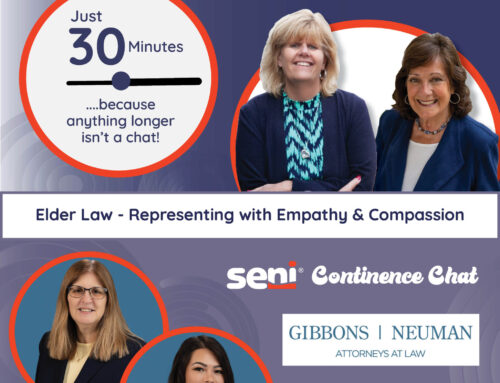No one likes to think about the possibility of their own disability or the disability of a loved one. However, as we’ll see below, the statistics are clear that we should all plan for at least a temporary disability. The statistics are eye-opening surrounding disability and some of the common disability planning options. Disability planning is one area where we can give each and every person and family we work with great comfort in knowing that, if the day comes for themselves or a loved one, they will be prepared.
Most Individuals Will Face At Least a Temporary Disability
Study after study confirms that nearly everyone will face at least a temporary disability sometime during their lifetime. More specifically, one in three Americans will face at least a 90-day disability before reaching age 65.
Planning Note: Many people fear what will happen to them if they become disabled. Discussing options and planning early (while capacity is not an issue) will help bring peace of mind and alleviate some of the fear surrounding this issue.
Many Persons Will Face a Long Term Disability
Unfortunately, for many Americans the disability will not be short-lived. According to the 2013 Center for Disease Control and Prevention Long term care Services study, over 8.3 million Americans received long term care services annually. That number is expected to double by 2050. At least 70% of people over 65 will need long-term care services and support at some point in their lives. It is not uncommon for someone to receive care at home for several months or longer, followed by a two and a half year stay in an assisted living facility, with almost 60% then requiring a nursing home stay of somewhere between nine months and a little over two years.
The Alzheimer’s Factor
Alzheimer’s is growing at an alarming rate. It is the 6th leading cause of death in the United States. cause of death between 2000 and 2006, while causes of death from prostate cancer, breast cancer, heart disease and HIV all declined during that time period. The Alzheimer’s Association states that:
- An estimated 5.5 million Americans of all ages have Alzheimer’s disease. This figure includes 5.3 million people aged 65 and older.
- One in 10 people aged 65 and older have Alzheimer’s disease.
- Every 66 seconds, someone in America develops Alzheimer’s. By mid-century, someone will develop the disease every 33 seconds.
- By 2050, the number of individuals aged 65 and older with Alzheimer’s could rise as high as 16 million – unless medical breakthroughs identify ways to prevent or more effectively treat the disease.
Planning Note: There is no treatment available to stop or slow the progression of Alzheimer’s. There are several drugs currently approved by the U.S. Food and Drug Administration that temporarily slow the worsening of symptoms for approximately six to twelve months in about half of the patients who take the drugs.
Caregivers are at risk of developing health problems. There were approximately 15 million unpaid caregivers (family members and friends) providing care to persons with Alzheimer’s or dementia. According to the Alzheimer’s Association, those persons are at high risk of developing health problems, or worsening existing health issues. For example, family and other unpaid caregivers of people with Alzheimer’s or another dementia are more likely than non-caregivers to have high levels of stress hormones, reduced immune function, slow wound healing, new hypertension and new coronary heart disease.
Spouses who are caregivers for the other spouse with Alzheimer’s or other dementia are at greater risk for emergency room visits due to their health deteriorating as the result of providing care. A study mentioned in an 2010 Alzheimer’s Association report found that caregivers of spouses who were hospitalized for dementia were more likely than caregivers of spouses who were hospitalized for other diseases to die in the following year.
Long-Term Care Costs Can Be Staggering
Not only will many individuals and families face prolonged long term care, in-home care and nursing home costs continue to rise. According to the 2017 Genworth Cost of care Survey national averages for long term care costs are as follows:
- Monthly base rate (room and board, two meals per day, house keeping and personal care assistance) for assisted living care is $3,750 or $45,000 annually.
- Daily rate for a private room in a nursing home is $267, or $97,455 annually.
- Daily rate for a semi-private room in a nursing home is $235, or $85,775 annually.
- Hourly rate for home health aides is $21.
These costs vary significantly by region, and thus it is critical to know the costs where the individual will receive care.
Long-Term Care Insurance May Cover These Costs
If a parent, their spouse, or family member needs long term care, the cost could easily deplete and/or extinguish the family’s hard-earned assets. Alternatively, seniors (or their families) can pay for long term care completely or in part through long term care insurance or a life insurance product with a long term care benefit rider. Most long term care insurance plans or hybrid plans let the individual choose the amount of the coverage she wants, as well as how and where she can use her benefits. A comprehensive plan includes benefits for all levels of care, custodial to skilled. Clients can receive care in a variety of settings, including the person’s home, assisted living facilities, adult day care centers or hospice facilities.
Planning in the Event Long Term Care Insurance is Unavailable or Insufficient
Unfortunately, many older Americans will either be medically ineligible for long term care insurance or unable to afford the premiums. In that event, more aggressive planning should be considered as early as possible to make sure life savings are not depleted as a result of having to pay out-of-pocket for care. With the help of an elder law attorney, a plan can be created that will protect much of the assets of an individual or couple that would otherwise be at risk of being depleted.
Planning Note: Elder law attorneys can assist individuals in creating a plan that will prevent the loss of one’s life savings to private health care costs. Often these plans involve the use of trusts (both revocable and irrevocable), expansive powers of attorney for financial and health care decisions, and other important legal documents.
All Planning Should Thoroughly Address Disability
When a person becomes disabled, he or she is often unable to make personal and/or financial decisions. If the disabled person cannot make these decisions, someone must have the legal authority to do so. Otherwise, the family must apply to the court for appointment of a guardian over the person or property, or both. Those who are old enough to remember the public guardianship proceedings for Groucho Marx recognize the need to avoid a guardianship proceeding if at all possible.
At a minimum, seniors need broad powers of attorney that will allow agents to handle all of their property upon disability, as well as the appointment of a decision-maker for health care decisions (the name of the legal document varies by state, but all accomplish the same thing). Alternatively, a fully funded revocable trust can ensure that the senior’s person and property will be cared for as desired, pursuant to the highest duty under the law – that of a trustee.
Planning Note: Seniors and their loved ones need properly drafted and well thought-out planning documents that address both their property and their person in the event of disability.
Conclusion
The above discussion outlines the minimum planning clients should consider in preparation for a possible disability. It is imperative that clients work with a team of professional advisors (legal, medical and financial) to ensure that, in light of their unique goals and objectives, their planning addresses all aspects of a potential disability. Please contact us if you have any questions or would like to discuss any information in this article further.








Stay In Touch